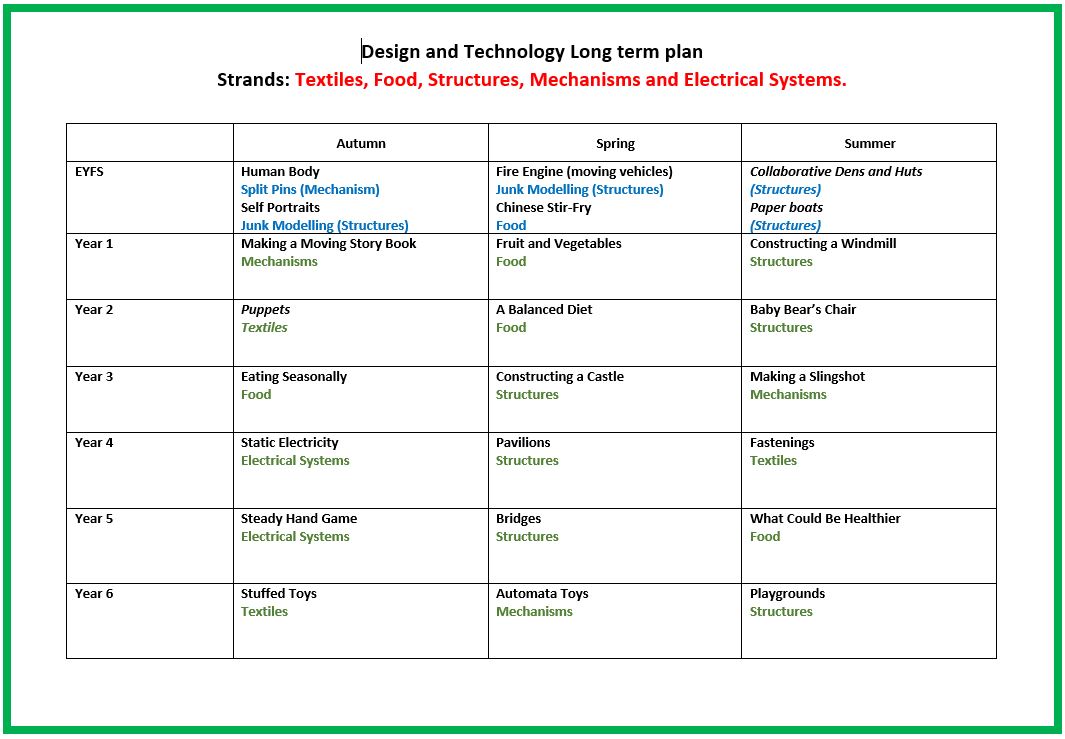Design Technology
Purpose and Aims
In a world where jobs and careers that pupils will be training to be part of, have not yet been invented, we want to create a design and technology curriculum that stands the test of time. Our curriculum equips pupils with the necessary skills to become resourceful, innovative, enterprising and capable citizens in an ever demanding, and increasingly technological world. The future of work is the work of imagination and the design technology curriculum allows our pupils to not only imagine but to create.
Design and Technology is an inspiring, practical subject that provides pupils with an uninhibited opportunity to use their creativity and imagination to design and make products that solve real and relevant problems. Part of the design and technology curriculum encourages children’s empathy of others through considerations, not only of their own wants and values, but those of others in their community. Pupils will be asked to evaluate past and present design and technology so that they develop a critical understanding of its impact on daily life and the wider world.
Pupils will acquire a broad range of subject knowledge and draw upon disciplines such as mathematics, science, engineering, computing and art. They will develop the creative, technical and practical expertise needed to perform everyday tasks confidently.
Planning and Assessment
The curriculum follows the Kapow Primary scheme of work and has been strengthened so that pupils revisit the learning in a spiral continuum curriculum. Pupils revisit strands and skills again, each time covering the same strand but with greater complexity and depth. As the pupils return to a previous strand prior learning is utilised, providing pupils with the foundations, and building blocks, in order to retain new information in the long term memory.
As the curriculum is revisited it is set out into strands that pupils will be exposed to throughout their primary years. The key areas are:
- Structures
- Mechanism/Mechanical Systems
- Cooking Nutrition
- Textiles
- Electrical Systems
- Digital World
Each area is visited once a year by children, with Electrical Systems and the Digital World starting in KS2. Within each area the pupils will gain an insight into structures and their principles and functionality. They will learn about specific techniques associated with the area of learning. They will build on vocabulary and make reference to symbols. Knowledge Organisers for these areas have been created to support pupil’s prior and future learning.
Domains have been designed to run alongside the National Curriculum requirements. These skills are:
- Design
- Make
- Evaluate
- Technical Knowledge
These skills enable pupils to develop creative, technical and practical expertise necessary in order to become confident in design and technology. They use knowledge and gain new understanding in order to refine their products and analyse their productivity. They are able to be self-reflective and critique their products, testing their theories and ideas as they work. The skills progression document formulated by Kapow Primary and enhanced by NET is used to ensure pupils have a balanced curriculum, with skills developing and interwoven throughout the primary phase.
In addition to this, pupils are able to understand the key components of nutrition, healthy living and how to create balanced meals.
Pupils follow a sequence of learning, starting with a big introduction, where they evaluate existing products. They then progress onto a sequence of lessons which allow pupils the opportunity to develop skills through a focus task, designing and making their product before evaluating against the intent and purpose.

Units are taught discretely but where links can be made to topics being taught they are, in order that pupils make meaningful connections whilst building up knowledge in their long term memory.
Organisation of the Curriculum
The Design and Technology curriculum is an exciting practical subject which can be found in many of the day to day objects pupils use. Design and technology is a part of children’s immediate experiences.

By the time a pupil leaves KS2 at NET, they will be able to:
- use their knowledge, understanding and skills to solve real and relevant problems
- use innovation and imagination to design and make products
- work as individuals and as part of a team, communicating their ideas through, models, diagrams and templates
- use practical skills and technical knowledge to improve products
- take risks with their design project in order to become enterprising citizens via the evaluation of products.
Enrichment
By enriching the curriculum we hope to provide extended learning opportunities for our children. Giving the pupil the chance to study concepts with greater depth, breadth and complexity, while also helping pupils to pursue their own areas of interest and strength.
Enrichment happens in the following ways:
Trips and Workshops: Workshops are designed to give our pupils some hands-on experience of designing and making in the real world. In addition to our workshops within school, pupils have also had the chance to visit places of interest such as the Science Museum
Home Learning and Competitions: Our pupils are given opportunities to apply their D.T. skills more independently by working on projects at home and with their families. We have held several competitions where pupils are challenged to create a range of free-standing structures at home, such as houses and landmarks.
Design Technology Opportunities: As part of all of our D.T. topics, pupils are given the chance to explore and experiment with different materials, skills and techniques. They are encouraged to practise the skills they have learned and taught to evaluate, adapt and improve their ideas over a period of time. This begins right away in our EYFS unit, where pupils have access to a wide range of tools and materials to explore in our continuous provision.

 Jerounds
Jerounds